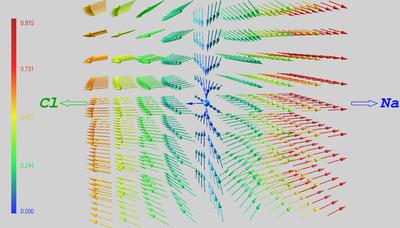当前位置:
X-MOL 学术
›
Acta Cryst. B
›
论文详情
Our official English website, www.x-mol.net, welcomes your
feedback! (Note: you will need to create a separate account there.)
Orbital‐free quantum crystallography: view on forces in crystals
Acta Crystallographica Section B ( IF 1.3 ) Pub Date : 2020-08-20 , DOI: 10.1107/s2052520620009178 Vladimir Tsirelson , Adam Stash
Acta Crystallographica Section B ( IF 1.3 ) Pub Date : 2020-08-20 , DOI: 10.1107/s2052520620009178 Vladimir Tsirelson , Adam Stash

|
Quantum theory of atoms in molecules and the orbital‐free density functional theory (DFT) are combined in this work to study the spatial distribution of electrostatic and quantum electronic forces acting in stable crystals. The electron distribution is determined by electrostatic electron mutual repulsion corrected for exchange and correlation, their attraction to nuclei and by electron kinetic energy. The latter defines the spread of permissible variations in the electron momentum resulting from the de Broglie relationship and uncertainty principle, as far as the limitations of Pauli principle and the presence of atomic nuclei and other electrons allow. All forces are expressed via kinetic and DFT potentials and then defined in terms of the experimental electron density and its derivatives; hence, this approach may be considered as orbital‐free quantum crystallography. The net force acting on an electron in a crystal at equilibrium is zero everywhere, presenting a balance of the kinetic Fkin(r) and potential forces F(r). The critical points of both potentials are analyzed and they are recognized as the points at which forces Fkin(r) and F(r) individually are zero (the Lagrange points). The positions of these points in a crystal are described according to Wyckoff notations, while their types depend on the considered scalar field. It was found that F(r) force pushes electrons to the atomic nuclei, while the kinetic force Fkin(r) draws electrons from nuclei. This favors formation of electron concentration bridges between some of the nearest atoms. However, in a crystal at equilibrium, only kinetic potential vkin(r) and corresponding force exhibit the electronic shells and atomic‐like zero‐flux basins around the nuclear attractors. The force‐field approach and quantum topological theory of atoms in molecules are compared and their distinctions are clarified.
中文翻译:

无轨道量子晶体学:关于晶体力的观点
这项工作结合了分子中原子的量子理论和无轨道密度泛函理论(DFT),以研究作用在稳定晶体中的静电力和量子电子力的空间分布。电子分布取决于为交换和相关而校正的静电电子互斥,其对原子核的吸引力以及电子动能。后者定义了由德布罗意关系和不确定性原理引起的电子动量的可允许变化范围,只要保利原理的局限性以及原子核和其他电子的存在就可以了。所有力都通过动力学和DFT势表示,然后根据实验电子密度及其导数来定义;因此,这种方法可被视为无轨道量子晶体学。平衡时作用在晶体中的电子上的净力在任何地方都为零,表示了动力学的平衡F kin( r)和势力F( r)。分析了两个电位的临界点,并将它们识别为力F kin( r)和F( r)分别为零的点(拉格朗日点)。这些点在晶体中的位置根据Wyckoff符号进行描述,而它们的类型则取决于所考虑的标量场。发现F( r)力将电子推到原子核,而动力学力F kin( r)从原子核吸取电子。这有利于在一些最接近的原子之间形成电子浓度桥。但是,在平衡晶体中,只有动势v kin(r)和相应的力才能在核吸引子周围显示出电子壳和类似原子的零通量池。比较了分子中原子的力场方法和量子拓扑理论,并阐明了它们的区别。
更新日期:2020-10-07
中文翻译:

无轨道量子晶体学:关于晶体力的观点
这项工作结合了分子中原子的量子理论和无轨道密度泛函理论(DFT),以研究作用在稳定晶体中的静电力和量子电子力的空间分布。电子分布取决于为交换和相关而校正的静电电子互斥,其对原子核的吸引力以及电子动能。后者定义了由德布罗意关系和不确定性原理引起的电子动量的可允许变化范围,只要保利原理的局限性以及原子核和其他电子的存在就可以了。所有力都通过动力学和DFT势表示,然后根据实验电子密度及其导数来定义;因此,这种方法可被视为无轨道量子晶体学。平衡时作用在晶体中的电子上的净力在任何地方都为零,表示了动力学的平衡F kin( r)和势力F( r)。分析了两个电位的临界点,并将它们识别为力F kin( r)和F( r)分别为零的点(拉格朗日点)。这些点在晶体中的位置根据Wyckoff符号进行描述,而它们的类型则取决于所考虑的标量场。发现F( r)力将电子推到原子核,而动力学力F kin( r)从原子核吸取电子。这有利于在一些最接近的原子之间形成电子浓度桥。但是,在平衡晶体中,只有动势v kin(r)和相应的力才能在核吸引子周围显示出电子壳和类似原子的零通量池。比较了分子中原子的力场方法和量子拓扑理论,并阐明了它们的区别。











































 京公网安备 11010802027423号
京公网安备 11010802027423号